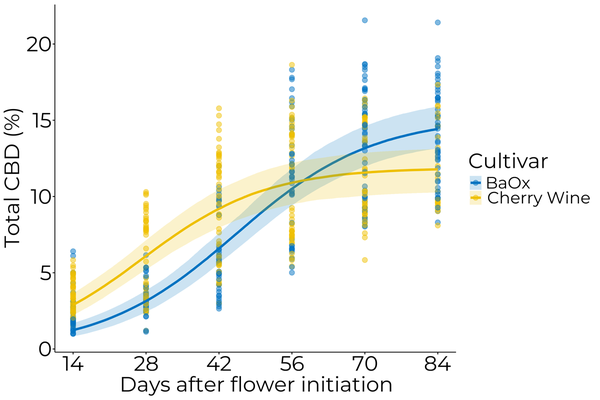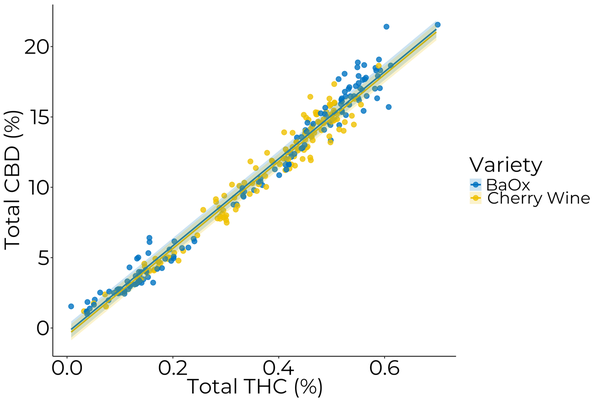Introduction
Farmers who produce floral hemp (Cannabis sativa L <0.3% total THC) for cannabidiol (CBD) extraction or as a smokeable product walk a thin line between maximizing CBD content and remaining below the 0.3% total THC compliance threshold. In a previous article, we discussed the unique biochemistry of CBD biosynthesis and how it is impossible to produce a crop without THC.
The CBDA synthase enzyme that is responsible for synthesizing CBD produces a small amount of THC at a ratio of roughly 20:1 (CBD:THC). Therefore, farmers can only expect to achieve 6% to 8% CBD before the crop becomes “hot” (above 0.3% total THC). Under the new USDA rules, farmers must have their crop tested 30 days before harvest. Understanding how CBD and THC accumulate over time is critical to ensuring the sampling and harvest of a compliant crop. We conducted field trials in 2020 and 2021 to understand how CBD and THC accumulate throughout floral development. Our goal was to develop appropriate sampling and harvest timing recommendations for floral hemp producers in North Carolina.
Field Studies
We used clones of ‘BaOx’ and ‘Cherry Wine’ floral hemp varieties in both years of the research. These varieties were planted in the first week of June at the Cunningham Research Station (Kinston, NC) and the Piedmont Research Station (Salisbury, NC). We harvested a total of 12 plants per variety per location (3 plants × 4 blocks) every two weeks beginning at two weeks after floral initiation until 12 weeks after floral initiation (6 harvest dates in total). The plants were dried in tobacco bulk barns at approximately 100° F for five days and then threshed by hand. The resultant biomass was submitted for cannabinoid analyses.
Total CBD Over Time
Total CBD is calculated as CBD + 0.877 × CBDA. Both varieties showed a strong sigmoid or S-shaped growth curve (Figure 1). There were few differences between the two varieties, although ‘Cherry Wine’ reached its maximum CBD content earlier than ‘BaOx’.
Total THC
Similar to total CBD, total THC is calculated as Δ9-THC + 0.877×THCA. Total THC also followed a very strong sigmoid curve, although we observed a decline in total THC toward the end of the season (Figure 2).
THC is more sensitive to environmental degradation than CBD, which explains why we did not observe the decline in CBD content at the end of the season (Yangsud et al. 2021). More importantly, we found that ‘Cherry Wine’ and ‘BaOx’ reached 0.3% total THC at 41 and 50 days, respectively, after floral initiation (DAF).
Finally, to determine the maximum amount of total CBD produced at 0.3% total THC, we plotted the two cannabinoids (Figure 3). Here we found that the 0.3% total THC threshold was met at approximately 8% total CBD.
Key Takeaways
Allowing floral hemp to maximize CBD production will result in a hot crop. We found that the time required to reach the 0.3% total THC threshold was dependent on the variety and ranged from 41 to 50 days after floral initiation. Consequently, we recommend that farmers have compliance samples collected no later than two weeks after floral initiation. At that stage of floral development, there will be reduced risk of a hot test for ‘BaOx’ and ‘Cherry Wine’. The USDA requires a crop to be harvested no later than 30 days after compliance sampling. Farmers can harvest the crop before that 30 day limit if they choose. When in doubt, the best way to monitor THC is to submit floral tissue samples to an analytical lab during floral development.
Literature Cited
Yangsud, Jiroj, Supadit Santasanasuwan, Pongphop Ahkkarachinoreh, Athip Maha, Fameera Madaka, Jirapornchai Suksaeree, Thanapat Songsak, Arthimond Vutthipong, and Chaowalit Monton. 2021. “Stability of Cannabidiol, ∆9-Tetrahydrocannabinol, and Cannabinol under Stress Conditions.” Advances in Traditional Medicine (Online) 21, no. 3: 475-484.
Acknowledgments
This work was partially funded by the North Carolina Agricultural Foundation, Inc.
Publication date: Aug. 18, 2022
AG-937
N.C. Cooperative Extension prohibits discrimination and harassment regardless of age, color, disability, family and marital status, gender identity, national origin, political beliefs, race, religion, sex (including pregnancy), sexual orientation and veteran status.



